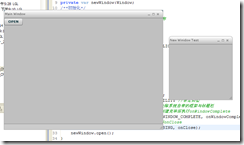AIR中窗口的关闭
Categories: Flex; Tagged with: AIR; @ October 21st, 2008 10:00在默认情况下, AIR程序中已经被关闭的窗口不可以再次打开的.因此我们通过visible属性 来模拟打开关闭[ 没有关闭, 只是隐藏]:
以下代码新建了一个窗口, 并监听Event.CLOSING事件, 阻止默认行为, 使得用户在点击关闭窗口时,窗口只隐藏而不关闭, 当用户再次点击主窗口的”OPEN”时, 该新窗口又会出现,.
import mx.messaging.AbstractConsumer;
import mx.events.AIREvent;
import mx.controls.Button;
import mx.core.Window;
private var newWindow:Window;
/**初始化*/
private function init():void {
title = "Main Window"; //设定标题栏显示的名称
addNewWindow(); //增加一个新窗口
//增加一个Button
var buttonOpen:Button = new Button();
buttonOpen.label = "OPEN";
buttonOpen.addEventListener(MouseEvent.CLICK, onOpenButtonClicked);
addChild(buttonOpen);
}
/**创建新窗口并打开*/
private function addNewWindow():void {
newWindow = new Window();
newWindow.width = 200;
newWindow.height = 200;
newWindow.title = "New Winidow Test";
newWindow.type = NativeWindowType.UTILITY //设定类型
newWindow.systemChrome = "none"; //去除系统自带的框架与标题栏
//监听AIREvent.WINDOW_COMPLETE函数,当创建完毕后执行onWindowComplete
newWindow.addEventListener(AIREvent.WINDOW_COMPLETE, onWindowComplete);
//监听Event.CLOSING,当用户点击关闭时,呼叫onClose
newWindow.addEventListener(Event.CLOSING, onClose);
newWindow.open();
}
/**创建完毕后的响应函数, 用于设定新窗口的位置*/
private function onWindowComplete(e:AIREvent):void {
e.target.stage.nativeWindow.x = (Capabilities.screenResolutionX - e.target.stage.nativeWindow.width)/2;
e.target.stage.nativeWindow.y = (Capabilities.screenResolutionY - e.target.stage.nativeWindow.height)/2;
}
/**当主窗口的"OPEN"点击后,执行该函数,将新窗口重新设置为active,看起来便是关闭后,点击"OPEN"将新窗口从新打开*/
private function onOpenButtonClicked(e:MouseEvent):void {
newWindow.activate();
}
/**当点击关闭后,将窗口设为不可见,同时阻止默认行为的发生*/
private function onClose(e:Event):void {
e.preventDefault();
newWindow.visible = false;
}
在一个MXML初始化时执行以上代码,变可出现以下结果:
点击新窗口关闭按钮时, 新窗口仅仅隐藏起来, 点击主窗口的”OPEN”时,将使得新窗口重新Active.
提示:
1.要监听Event.CLOSING事件, 不要搞成Event.CLOSE事件了….[最近表达能力有点小欠缺, 描述不清楚, 只好用”搞”]…
2. 主窗口不使用系统自带的框架与标题栏, 须在配置文件中设定 详见上一篇文章… 新窗口使用newWindow.systemChrome = “none”; 便可完成该效果.
略微总结下Air工程中的xml配置[描述]文件 <->
ActionScript
Adobe
AIR
ANT
Apache
ApacheFlex
Apache Flex
Better Developer
BlazeDS
Cloud Computing
CMD
DataGrid
DataGridColumn
DB2
Derby
DTSX
Eclipse
ETL
Event
Excel
Flash Builder
Flex
Google
Java
JDBC
JDK
JIRA
Life@SG|新加坡
Linux
MySQL
Oracle
PHP
Python
RegEx
Servlet
SQL
SQL Server
SSIS
SVN
T-SQL
Tools
Tree
Ugly
WordPress
XML
dev-notes
side-projects
